A 40-Year Time Series of Land Surface Emissivity Derived from AVHRR Sensors: A Fennoscandian Perspective
Abstract
1. Introduction
Land Surface Emissivity
2. Materials and Methods
2.1. Study Area
2.2. AVHRR LAC L1C Data
2.3. MODIS MOD11A2 Data
2.4. NDVI 10-Day MED Composites
2.5. Emissivity Retrieval
2.5.1. NDVI Threshold Method
2.5.2. Dataset Generation
3. Results
3.1. The 40-Year Time Series
3.2. Comparison to MODIS
4. Discussion
4.1. Emissivity Retrieval
4.2. Time Series
4.3. Impact of Land Cover and Latitude
4.4. Comparison to MODIS
4.5. Uncertainty Sources
4.6. Limitations
5. Conclusions
Author Contributions
Funding
Data Availability Statement
Acknowledgments
Conflicts of Interest
References
- Valor, E. Mapping land surface emissivity from NDVI: Application to European, African, and South American areas. Remote Sens. Environ. 1996, 57, 167–184. [Google Scholar] [CrossRef]
- Hulley, G.C.; Hook, S.J.; Abbott, E.; Malakar, N.; Islam, T.; Abrams, M. The ASTER Global Emissivity Dataset (ASTER GED): Mapping Earth’s emissivity at 100 meter spatial scale. Geophys. Res. Lett. 2015, 42, 7966–7976. [Google Scholar] [CrossRef]
- Li, Z.; Wu, H.; Duan, S.; Zhao, W.; Ren, H.; Liu, X.; Leng, P.; Tang, R.; Ye, X.; Zhu, J.; et al. Satellite Remote Sensing of Global Land Surface Temperature: Definition, Methods, Products, and Applications. Rev. Geophys. 2023, 61, e2022RG000777. [Google Scholar] [CrossRef]
- Global Climate Observing System (GCOS). The Global Observing System for Climate: Implementation Needs; Technical Report GCOS-200; World Meteorological Organization: Geneva, Switzerland, 2016. [Google Scholar]
- Chao, Q.; Han Dolman, A.J.; Herold, M.; Krug, T.; Speich, S.; Suda, K.; Thorne, P.; Yu, W.; Zemp, M. GCOS 2022 Implementation Plan; Technical Report; World Meteorological Organization: Geneva, Switzerland, 2022. [Google Scholar] [CrossRef]
- Li, Z.L.; Tang, B.H.; Wu, H.; Ren, H.; Yan, G.; Wan, Z.; Trigo, I.F.; Sobrino, J.A. Satellite-derived land surface temperature: Current status and perspectives. Remote Sens. Environ. 2013, 131, 14–37. [Google Scholar] [CrossRef]
- Li, Z.L.; Wu, H.; Wang, N.; Qiu, S.; Sobrino, J.A.; Wan, Z.; Tang, B.H.; Yan, G. Land surface emissivity retrieval from satellite data. Int. J. Remote Sens. 2013, 34, 3084–3127. [Google Scholar] [CrossRef]
- Wan, Z.; Dozier, J. A generalized split-window algorithm for retrieving land-surface temperature from space. IEEE Trans. Geosci. Remote Sens. 1996, 34, 892–905. [Google Scholar] [CrossRef]
- Ghent, D.J.; Corlett, G.K.; Göttsche, F.M.; Remedios, J.J. Global Land Surface Temperature From the Along-Track Scanning Radiometers. J. Geophys. Res. Atmos. 2017, 122, 12167–12193. [Google Scholar] [CrossRef]
- Waring, A.M.; Ghent, D.; Perry, M.; Anand, J.S.; Veal, K.L.; Remedios, J. Regional climate trend analyses for Aqua MODIS land surface temperatures. Int. J. Remote Sens. 2023, 44, 4989–5032. [Google Scholar] [CrossRef]
- Jiménez-Muñoz, J.C.; Sobrino, J.A.; Gillespie, A.; Sabol, D.; Gustafson, W.T. Improved land surface emissivities over agricultural areas using ASTER NDVI. Remote Sens. Environ. 2006, 103, 474–487. [Google Scholar] [CrossRef]
- Neinavaz, E.; Schlerf, M.; Darvishzadeh, R.; Gerhards, M.; Skidmore, A.K. Thermal infrared remote sensing of vegetation: Current status and perspectives. Int. J. Appl. Earth Obs. Geoinf 2021, 102, 102415. [Google Scholar] [CrossRef]
- Schädlich, S. Influence of Land Surface Parameters and Atmosphere on METEOSAT Brightness Temperatures and Generation of Land Surface Temperature Maps by Temporally and Spatially Interpolating Atmospheric Correction. Remote Sens. Environ. 2001, 75, 39–46. [Google Scholar] [CrossRef]
- Sobrino, J.; Coll, C.; Caselles, V. Atmospheric correction for land surface temperature using NOAA-11 AVHRR channels 4 and 5. Remote Sens. Environ. 1991, 38, 19–34. [Google Scholar] [CrossRef]
- Becker, F. The impact of spectral emissivity on the measurement of land surface temperature from a satellite. Int. J. Remote Sens. 1987, 8, 1509–1522. [Google Scholar] [CrossRef]
- Palmtag, J.; Obu, J.; Kuhry, P.; Richter, A.; Siewert, M.B.; Weiss, N.; Westermann, S.; Hugelius, G. A high spatial resolution soil carbon and nitrogen dataset for the northern permafrost region based on circumpolar land cover upscaling. Earth Syst. Sci. Data 2022, 14, 4095–4110. [Google Scholar] [CrossRef]
- Rantanen, M.; Kämäräinen, M.; Niittynen, P.; Phoenix, G.K.; Lenoir, J.; Maclean, I.; Luoto, M.; Aalto, J. Bioclimatic atlas of the terrestrial Arctic. Sci. Data 2023, 10, 40. [Google Scholar] [CrossRef]
- Pearson, R.G.; Phillips, S.J.; Loranty, M.M.; Beck, P.S.; Damoulas, T.; Knight, S.J.; Goetz, S.J. Shifts in Arctic vegetation and associated feedbacks under climate change. Nat. Clim. Change 2013, 3, 673–677. [Google Scholar] [CrossRef]
- Sturm, M.; Schimel, J.; Michaelson, G.; Welker, J.M.; Oberbauer, S.F.; Liston, G.E.; Fahnestock, J.; Romanovsky, V.E. Winter Biological Processes Could Help Convert Arctic Tundra to Shrubland. BioScience 2005, 55, 17–26. [Google Scholar] [CrossRef]
- Wielgolaski, F.E. (Ed.) Fennoscandian Tundra Ecosystems: Part 1 Plants and Microorganisms, 1st ed.; Ecological Studies; Springer: Berlin/Heidelberg, Germany, 1975; Volume 16, p. 368. [Google Scholar] [CrossRef]
- Lagergren, F.; Björk, R.G.; Andersson, C.; Belušić, D.; Björkman, M.P.; Kjellström, E.; Lind, P.; Lindstedt, D.; Olenius, T.; Pleijel, H.; et al. Kilometre-scale simulations over Fennoscandia reveal a large loss of tundra due to climate warming. Biogeosciences 2024, 21, 1093–1116. [Google Scholar] [CrossRef]
- Liu, C.; Huang, H.; Liu, C.; Wang, X.; Wang, S. Comparative evaluation of vegetation greenness trends over circumpolar Arctic tundra using multi-sensors satellite datasets. Int. J. Digi. Earth 2024, 17, 2328823. [Google Scholar] [CrossRef]
- Hulley, G.; Veraverbeke, S.; Hook, S. Thermal-based techniques for land cover change detection using a new dynamic MODIS multispectral emissivity product (MOD21). Remote Sens. Environ. 2014, 140, 755–765. [Google Scholar] [CrossRef]
- Hüsler, F.; Fontana, F.; Neuhaus, C.; Riffler, M.; Musial, J.; Wunderle, S. AVHRR Archive and Processing Facility at the University of Bern: A comprehensive 1-km satellite data set for climate change studies. EARSeL eProceedings 2011, 10, 83–101. [Google Scholar]
- Trigo, I.F.; Peres, L.F.; DaCamara, C.C.; Freitas, S.C. Thermal Land Surface Emissivity Retrieved From SEVIRI/Meteosat. IEEE Trans. Geosci. Remote Sens. 2008, 46, 307–315. [Google Scholar] [CrossRef]
- Sobrino, J.A.; Jimenez-Munoz, J.C.; Soria, G.; Romaguera, M.; Guanter, L.; Moreno, J.; Plaza, A.; Martinez, P. Land Surface Emissivity Retrieval From Different VNIR and TIR Sensors. IEEE Trans. Geosci. Remote Sens. 2008, 46, 316–327. [Google Scholar] [CrossRef]
- Sobrino, J.A.; Raissouni, N. Toward remote sensing methods for land cover dynamic monitoring: Application to Morocco. Int. J. Remote Sens. 2000, 21, 353–366. [Google Scholar] [CrossRef]
- Sobrino, J. A Comparative Study of Land Surface Emissivity Retrieval from NOAA Data. Remote Sens. Environ. 2001, 75, 256–266. [Google Scholar] [CrossRef]
- Xue, S.Y.; Xu, H.Y.; Mu, C.C.; Wu, T.H.; Li, W.P.; Zhang, W.X.; Streletskaya, I.; Grebenets, V.; Sokratov, S.; Kizyakov, A.; et al. Changes in different land cover areas and NDVI values in northern latitudes from 1982 to 2015. Adv. Clim. Change Res. 2021, 12, 456–465. [Google Scholar] [CrossRef]
- Wan, Z.; Hook, S.; Hulley, G. MODIS/Terra Land Surface Temperature/Emissivity 8-Day L3 Global 1 km SIN Grid V061; Technical Report; USGS: Reston, VA, USA, 2021. [CrossRef]
- World Meteorological Organization. Implementation Plan for the Global Observing System for Climate in Support of the UNFCCC; Technical Report GOOS-184, GTOS-76, WMO-TD/No. 1523; World Meteorological Organization (WMO): Geneva, Switzerland, 2010. [Google Scholar]
- Becker, F.; Li, Z. Surface temperature and emissivity at various scales: Definition, measurement and related problems. Remote Sens. Rev. 1995, 12, 225–253. [Google Scholar] [CrossRef]
- Cheng, J.; Liang, S.; Meng, X.; Quan, Z.; Zhou, S. Chapter 7—Land surface temperature and thermal infrared emissivity. In Advanced Remote Sensing, 2nd ed.; Liang, S., Wang, J., Eds.; Academic Press: Cambridge, MA, USA, 2020; pp. 251–295. [Google Scholar] [CrossRef]
- McCluney, W.R. Introduction to Radiometry and Photometry, 2nd ed.; Artech House: Norwood, MA, USA, 2014. [Google Scholar]
- Quattrochi, D.A.; Luvall, J.C. (Eds.) Thermal Remote Sensing in Land Surface Processes, 1st ed.; CRC Press: Boca Raton, FL, USA, 2004. [Google Scholar] [CrossRef]
- Stathopoulou, M.; Cartalis, C.; Petrakis, M. Integrating Corine Land Cover data and Landsat TM for surface emissivity definition: Application to the urban area of Athens, Greece. Int. J. Remote Sens. 2007, 28, 3291–3304. [Google Scholar] [CrossRef]
- Jin, M.; Liang, S. An Improved Land Surface Emissivity Parameter for Land Surface Models Using Global Remote Sensing Observations. J. Clim. 2006, 19, 2867–2881. [Google Scholar] [CrossRef]
- Van De Griend, A.A.; Owe, M. On the relationship between thermal emissivity and the normalized difference vegetation index for natural surfaces. Int. J. Remote Sens. 1993, 14, 1119–1131. [Google Scholar] [CrossRef]
- Pinheiro, A.; Mahoney, R.; Privette, J.; Tucker, C. Development of a daily long term record of NOAA-14 AVHRR land surface temperature over Africa. Remote Sens. Environ. 2006, 103, 153–164. [Google Scholar] [CrossRef]
- Dozier, J.; Warren, S.G. Effect of viewing angle on the infrared brightness temperature of snow. Water Resour. Res. 1982, 18, 1424–1434. [Google Scholar] [CrossRef]
- Meerdink, S.K.; Hook, S.J.; Roberts, D.A.; Abbott, E.A. The ECOSTRESS spectral library version 1.0. Remote Sens. Environ. 2019, 230, 111196. [Google Scholar] [CrossRef]
- Baldridge, A.; Hook, S.; Grove, C.; Rivera, G. The ASTER spectral library version 2.0. Remote Sens. Environ. 2009, 113, 711–715. [Google Scholar] [CrossRef]
- European Space Agency (ESA). Land Cover CCI Product User Guide Version 2. Technical Report, European Space Agency. 2017. Available online: http://maps.elie.ucl.ac.be/CCI/viewer/download/ESACCI-LC-Ph2-PUGv2_2.0.pdf (accessed on 20 May 2024).
- Weber, H.; Naegeli, K.; Wunderle, S. Impact of Forest Canopy Parameterization on Space-Borne Snow on Ground Detection. In Proceedings of the 2021 IEEE International Geoscience and Remote Sensing Symposium IGARSS, Brussels, Belgium, 11–16 July 2021; pp. 864–867. [Google Scholar] [CrossRef]
- Emery, W.; Camps, A. Chapter 9—Ocean Applications. In Introduction to Satellite Remote Sensing; Elsevier: Amsterdam, The Netherlands, 2017; pp. 637–699. [Google Scholar] [CrossRef]
- Wunderle, S.; Neuhaus, C.; Brooks, A.; Hüsler, F.; Lonie, N.; Albani, M.; Folco, S.; Leone, R. Preservation and harmonization of historical AVHRR LAC data to serve the needs of users in climate research. In Proceedings of the 2017 Conference on Big Data from Space (BIDS’ 2017), Toulouse, France, 28–30 November 2017. [Google Scholar] [CrossRef]
- Khlopenkov, K.; Trishchenko, A.; Luo, Y. Achieving Subpixel Georeferencing Accuracy in the Canadian AVHRR Processing System. IEEE Trans. Geosci. Remote Sens. 2010, 48, 2150–2161. [Google Scholar] [CrossRef]
- Aksakal, S.; Neuhaus, C.; Baltsavias, E.; Schindler, K. Geometric Quality Analysis of AVHRR Orthoimages. Remote Sens. 2015, 7, 3293–3319. [Google Scholar] [CrossRef]
- EUMETSAT. AVHRR Level 1b Product Guide; Technical Report; EUMETSAT: Darmstadt, Germany, 2011. [Google Scholar]
- Heidinger, A.K.; Straka, W.C.; Molling, C.C.; Sullivan, J.T.; Wu, X. Deriving an inter-sensor consistent calibration for the AVHRR solar reflectance data record. Int. J. Remote Sens. 2010, 31, 6493–6517. [Google Scholar] [CrossRef]
- Kidwell, K.B. NOAA Polar Orbiter Data (POD) User’s Guide (TIROS-N, NOAA-6, -7, -8, -9, -10, -11, -12, -13 and -14); Technical Report; NOAA: Washington, DC, USA, 1998.
- Walton, C.C.; Sullivan, J.T.; Rao, C.R.N.; Weinreb, M.P. Corrections for detector nonlinearities and calibration inconsistencies of the infrared channels of the advanced very high resolution radiometer. J. Geophys Res. Ocean. 1998, 103, 3323–3337. [Google Scholar] [CrossRef]
- Snyder, W.C.; Wan, Z.; Zhang, Y.; Feng, Y.Z. Classification-based emissivity for land surface temperature measurement from space. Int. J. Remote Sens. 1998, 19, 2753–2774. [Google Scholar] [CrossRef]
- SMHI. The NWC SAF/PPS. Available online: https://nwcsaf.smhi.se/ (accessed on 12 June 2024).
- Fontana, F.M.; Trishchenko, A.P.; Khlopenkov, K.V.; Luo, Y.; Wunderle, S. Impact of orthorectification and spatial sampling on maximum NDVI composite data in mountain regions. Remote Sens. Environ. 2009, 113, 2701–2712. [Google Scholar] [CrossRef]
- Trishchenko, A.P.; Cihlar, J.; Li, Z. Effects of spectral response function on surface reflectance and NDVI measured with moderate resolution satellite sensors. Remote Sens. Environ. 2002, 81, 1–18. [Google Scholar] [CrossRef]
- Trishchenko, A.P. Effects of spectral response function on surface reflectance and NDVI measured with moderate resolution satellite sensors: Extension to AVHRR NOAA-17, 18 and METOP-A. Remote Sens. Environ. 2009, 113, 335–341. [Google Scholar] [CrossRef]
- Lieberherr, G.; Wunderle, S. Lake Surface Water Temperature Derived from 35 Years of AVHRR Sensor Data for European Lakes. Remote Sens. 2018, 10, 990. [Google Scholar] [CrossRef]
- Dupuis, S.; Rivoire, P.; Barben, M.; Wunderle, S. 40-Year AVHRR Top-of-Atmosphere NDVI Dataset. 2024. Available online: https://boris-portal.unibe.ch/entities/product/158bc761-44d4-4b55-a33e-03474768c592 (accessed on 20 May 2024). [CrossRef]
- Jacob, F.; Lesaignoux, A.; Olioso, A.; Weiss, M.; Caillault, K.; Jacquemoud, S.; Nerry, F.; French, A.; Schmugge, T.; Briottet, X.; et al. Reassessment of the temperature-emissivity separation from multispectral thermal infrared data: Introducing the impact of vegetation canopy by simulating the cavity effect with the SAIL-Thermique model. Remote Sens. Environ. 2017, 198, 160–172. [Google Scholar] [CrossRef]
- Sobrino, J.; Caselles, V.; Becker, F. Significance of the remotely sensed thermal infrared measurements obtained over a citrus orchard. ISPRS J. Photogramm. Remote Sens. 1990, 44, 343–354. [Google Scholar] [CrossRef]
- Lillesand, T.; Kiefer, R.; Chipman, J. Chapter 4—Multispectral, Thermal and Hyperspectral Sensing. In Remote Sensing and Image Interpretation, 7th ed.; John Wiley: Hoboken, NJ, USA, 2015. [Google Scholar]
- Korchagina, I.; Goleva, O.; Savchenko, Y.; Bozhikov, T. The use of geographic information systems for forest monitoring. J. Phys. Conf. Ser. 2020, 1515, 032077. [Google Scholar] [CrossRef]
- Weber, H. GCOS Switzerland Project: Fractional Snow Cover Time Series (1981–2021)—A Novel Dataset from Space to Support Climate Studies in Switzerland, Final Report; Technical Report; Federal Office of Meteorology and Climatology—MeteoSwiss: Zurich, Switzerland, 2022. [Google Scholar]
- Obrecht, L.; Göttsche, F.M.; Senn, J.A.; Cermak, J. Mapping Changes in Fractional Vegetation Cover on the Namib Gravel Plains with Satellite-Retrieved Land Surface Emissivity Data. Remote Sens. 2024, 16, 159. [Google Scholar] [CrossRef]
- Nagol, J.R. Quantification of Error in AVHRR NDVI Data. Ph.D. Thesis, University of Maryland, College Park, MD, USA, 2011. [Google Scholar]
- Fan, X.; Liu, Y. A global study of NDVI difference among moderate-resolution satellite sensors. ISPRS J. Photogramm. Remote Sens. 2016, 121, 177–191. [Google Scholar] [CrossRef]
- Kim, Y.; Huete, A.; Jiang, Z.; Miura, T. Multisensor reflectance and vegetation index comparisons of Amazon tropical forest phenology with hyperspectral Hyperion data. SPIE Conf. Proc. 2007, 6679, 54–63. [Google Scholar] [CrossRef]
- Holben, B.N. Characteristics of maximum-value composite images from temporal AVHRR data. Int. J. Remote Sens. 1986, 7, 1417–1434. [Google Scholar] [CrossRef]
- Asam, S.; Eisfelder, C.; Hirner, A.; Reiners, P.; Holzwarth, S.; Bachmann, M. AVHRR NDVI Compositing Method Comparison and Generation of Multi-Decadal Time Series—A TIMELINE Thematic Processor. Remote Sens. 2023, 15, 1631. [Google Scholar] [CrossRef]
- Tomlinson, C.J.; Chapman, L.; Thornes, J.E.; Baker, C. Remote sensing land surface temperature for meteorology and climatology: A review. Meteorol. Appl. 2011, 18, 296–306. [Google Scholar] [CrossRef]
- Jia, G.J.; Epstein, H.E.; Walker, D.A. Spatial characteristics of AVHRR-NDVI along latitudinal transects in northern Alaska. J. Veg. Sci. 2002, 13, 315–326. [Google Scholar] [CrossRef]

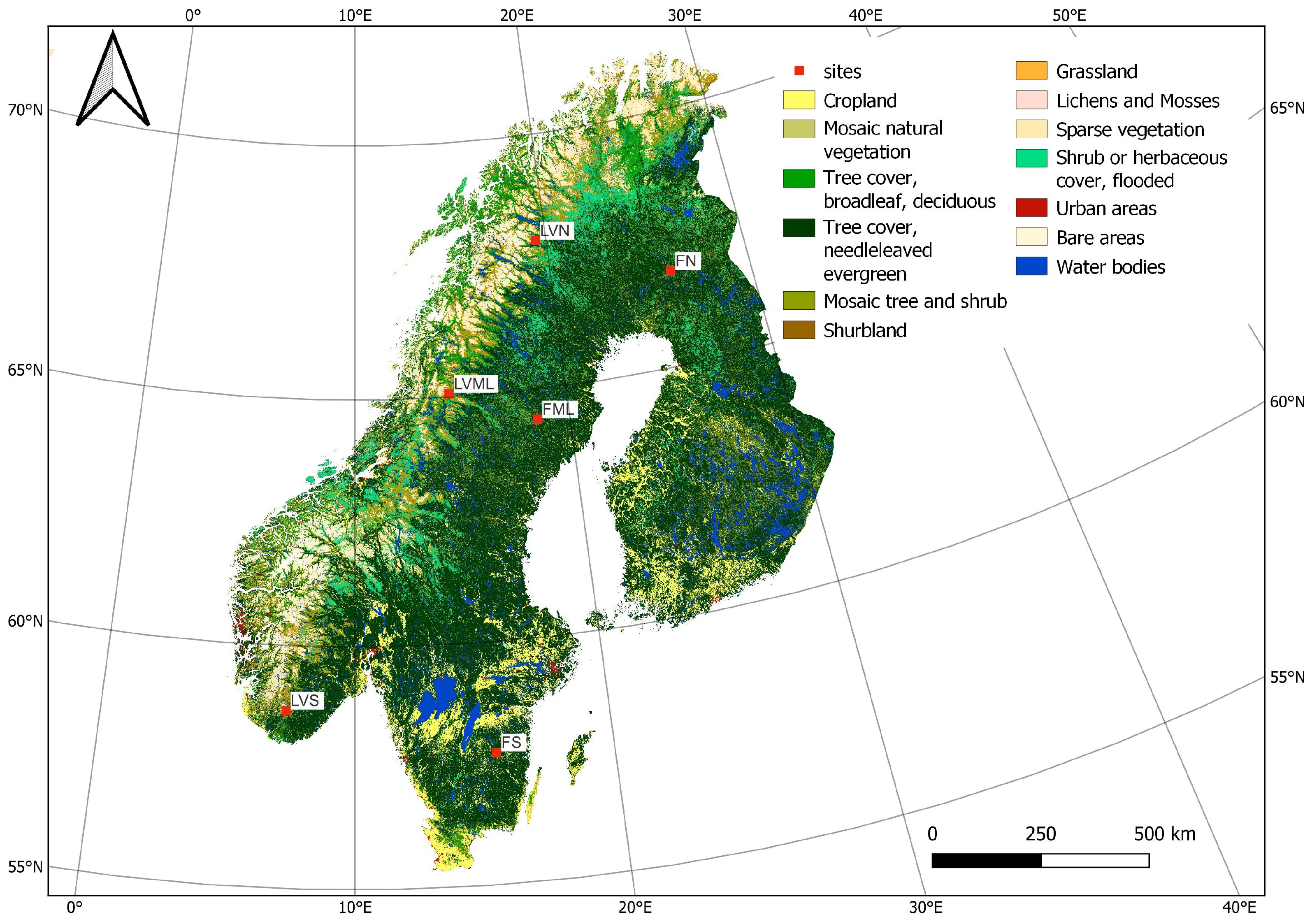
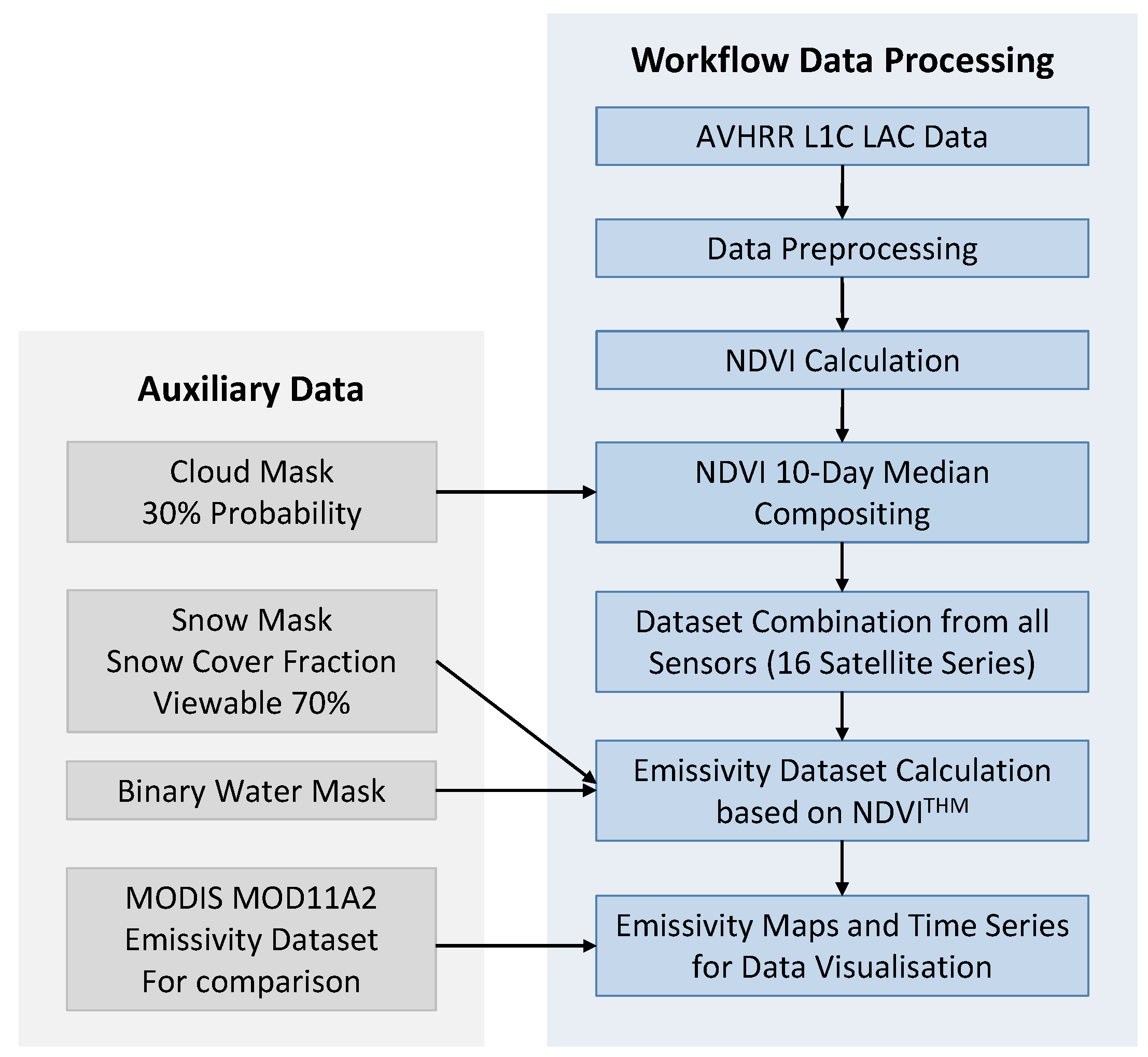
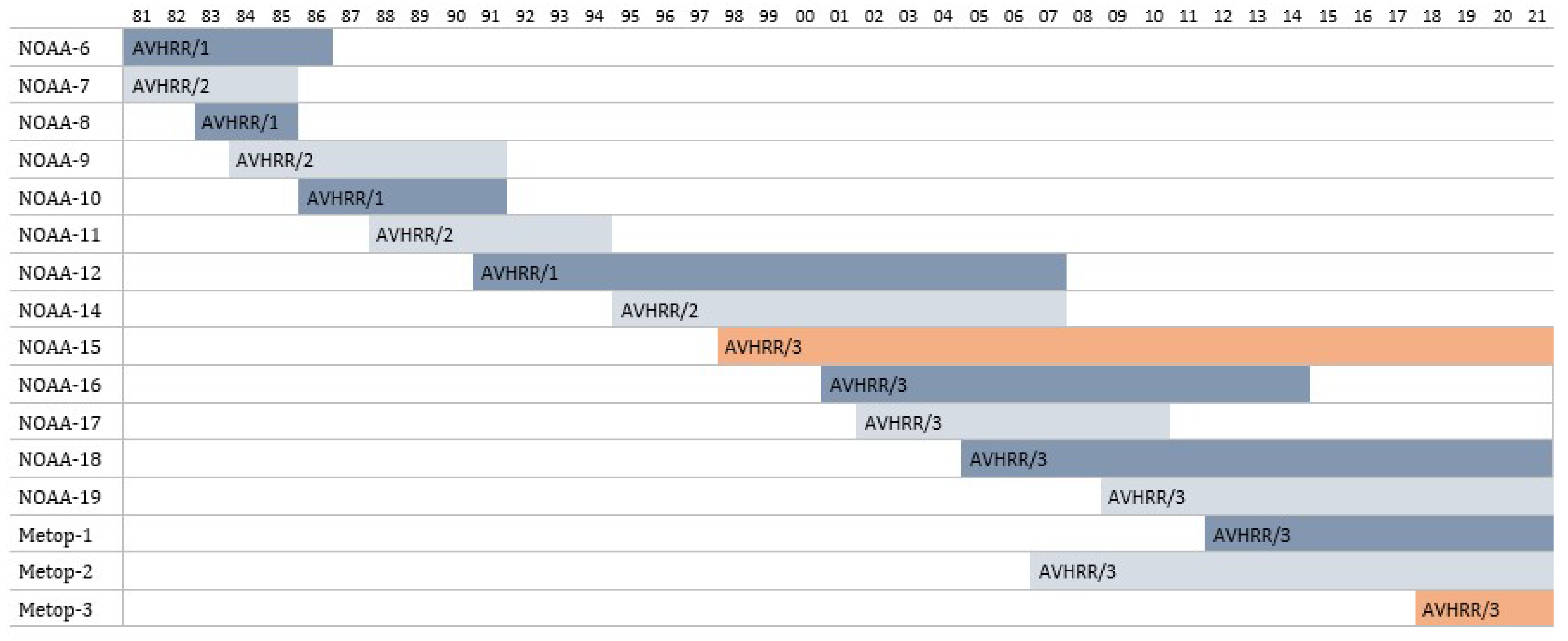
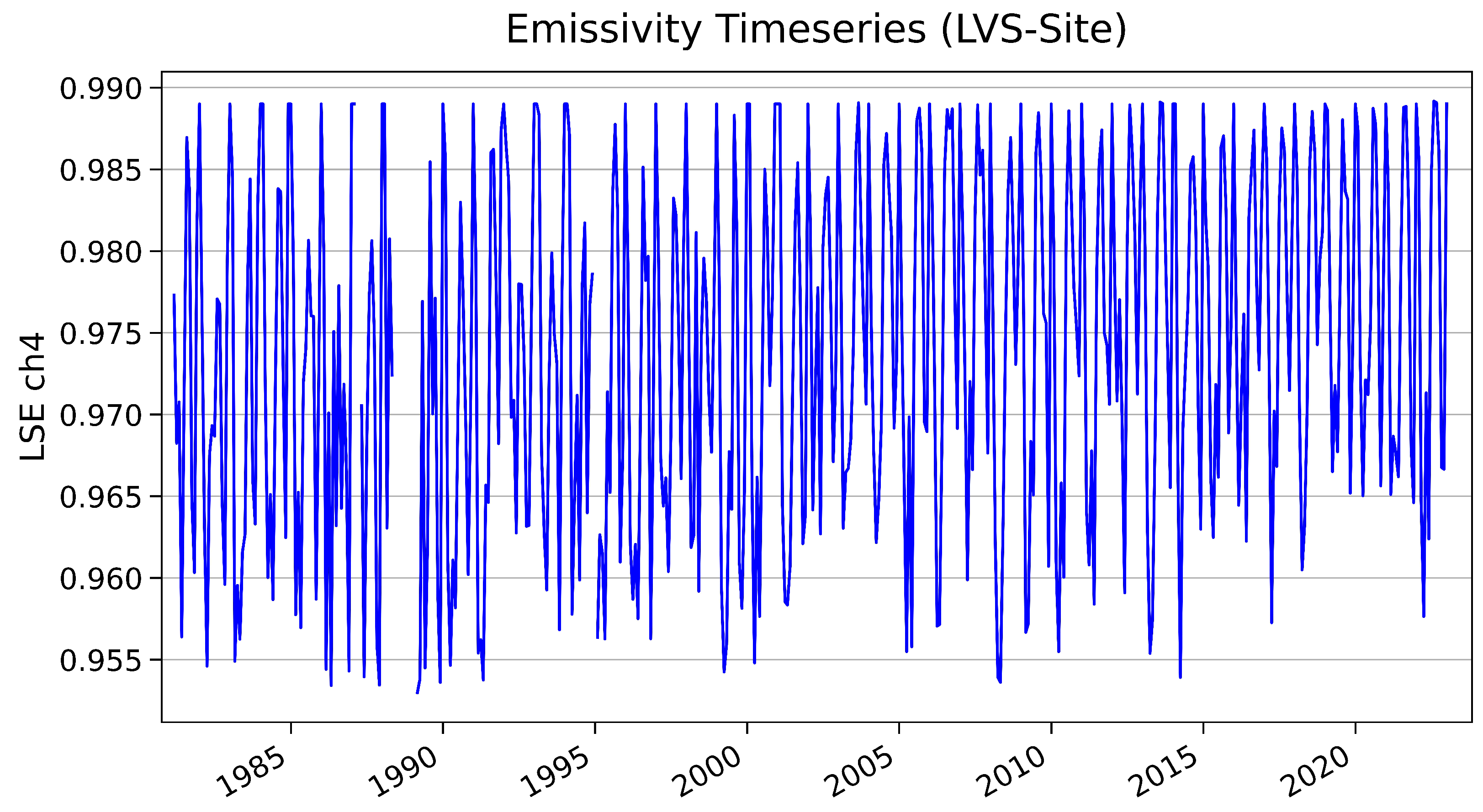
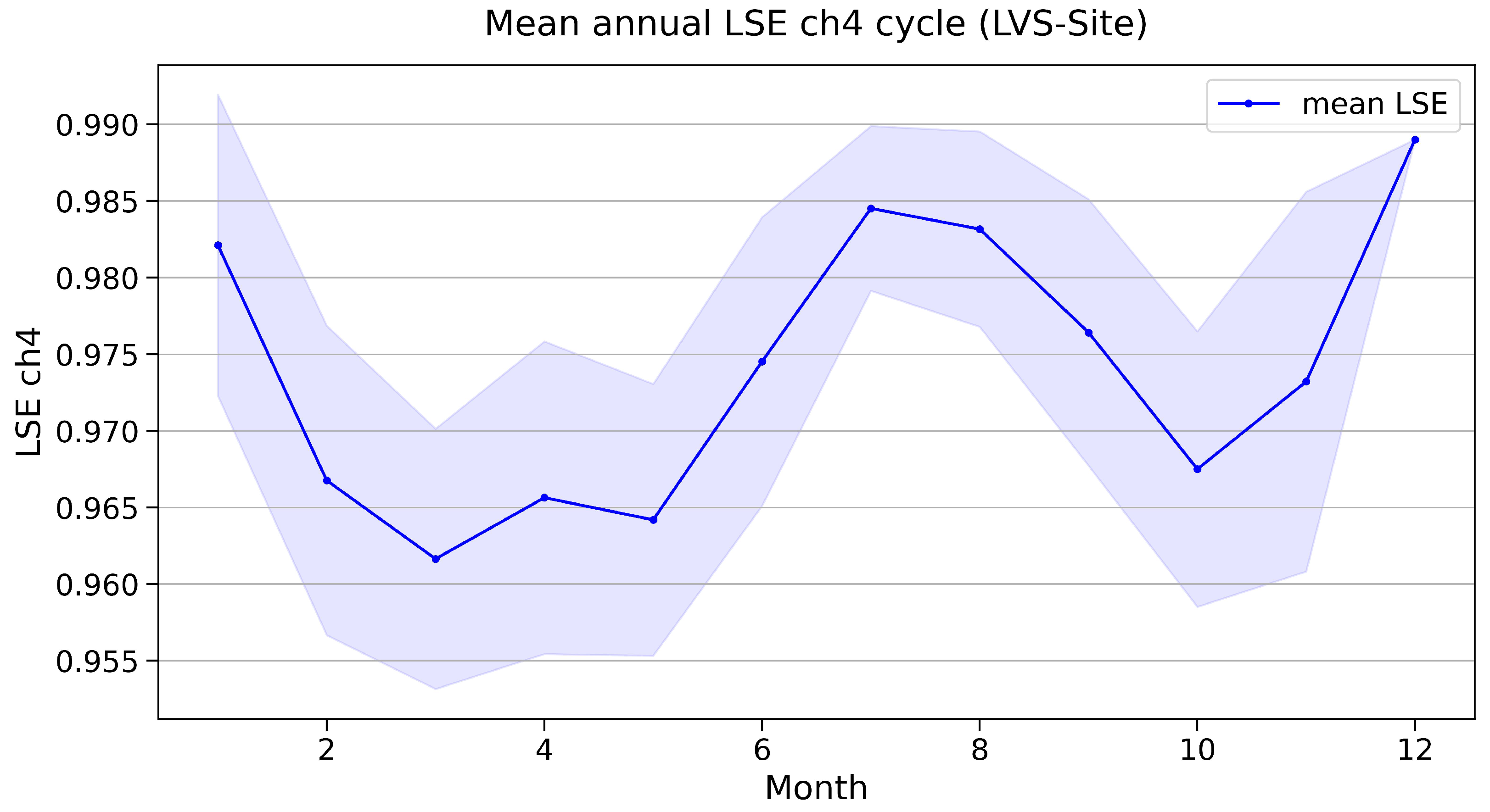

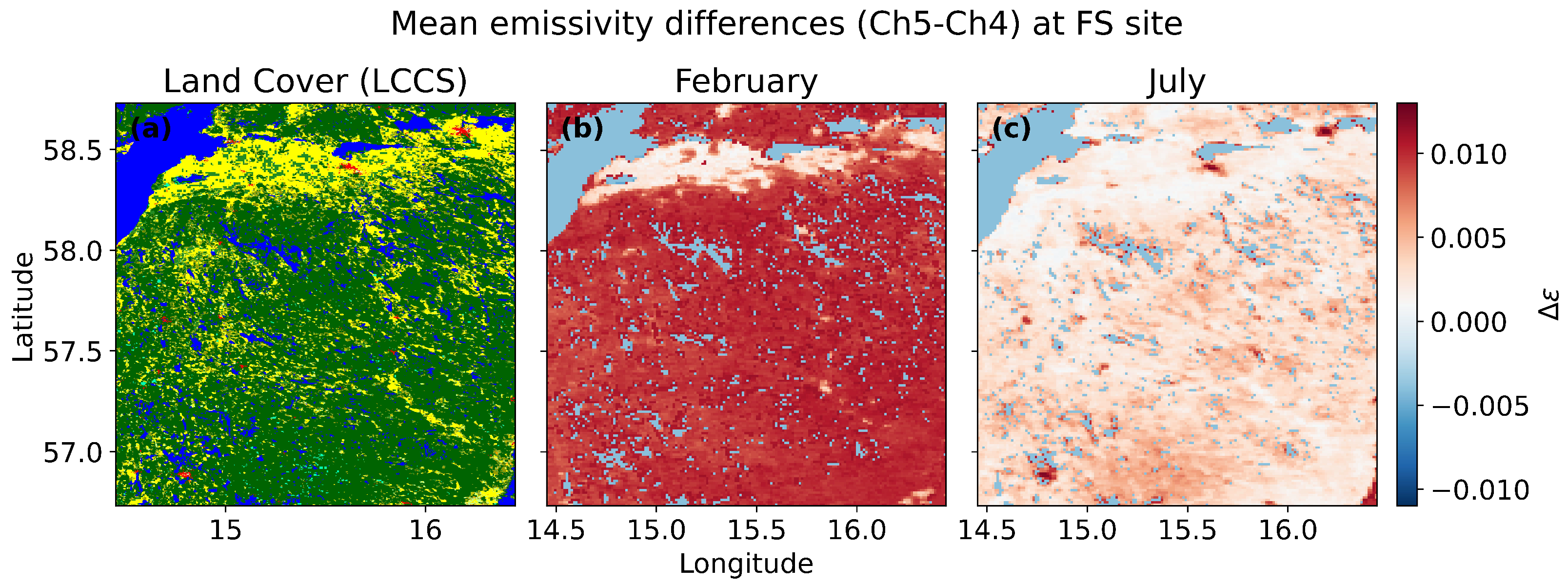
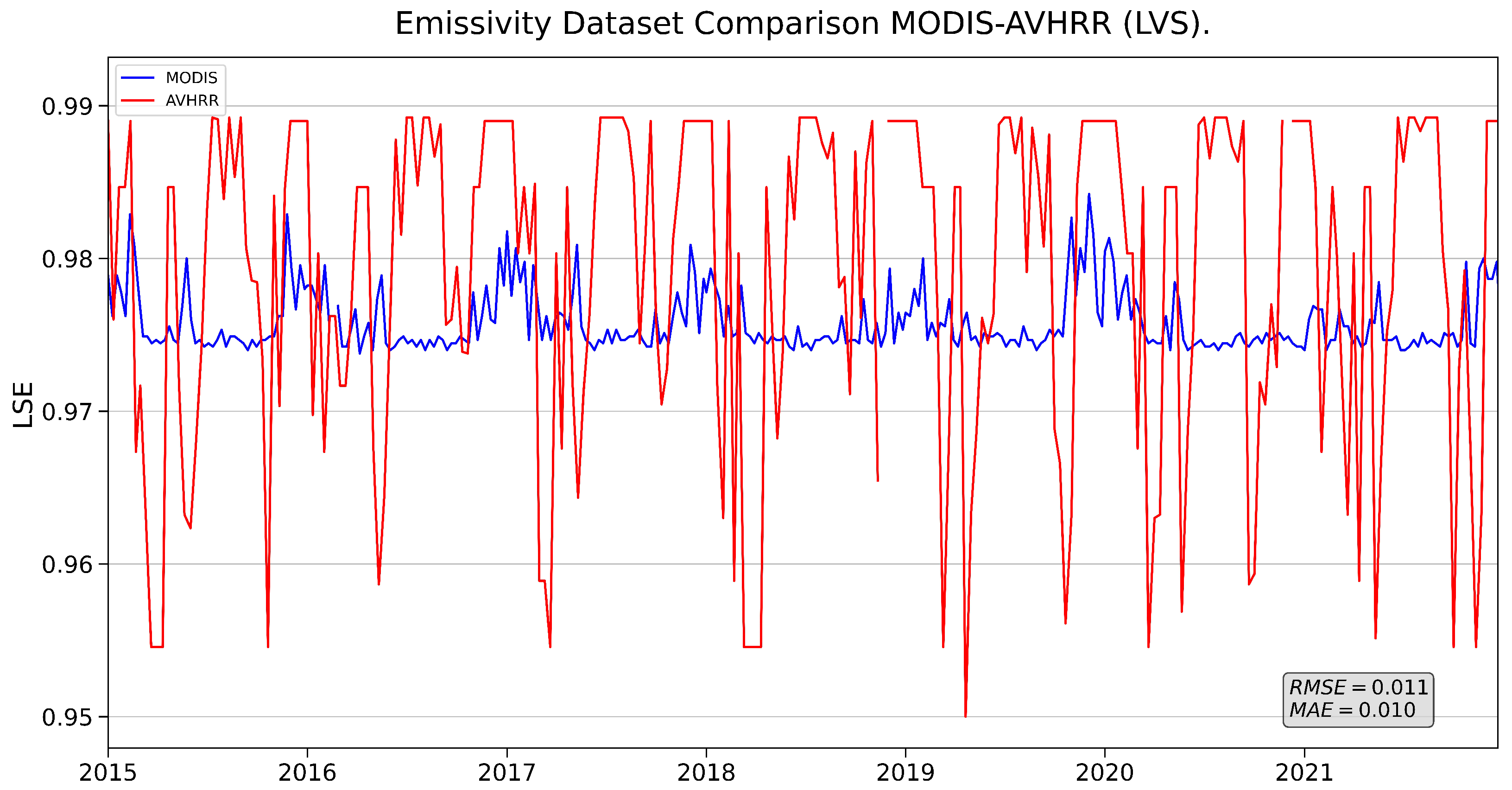
| Study Site | Latitude | Longitude | Land Cover |
|---|---|---|---|
| Low Vegetation South (LVS) | 58.67 | 7.28 | Mosaic herbaceous cover (>50%)/tree and shrub (<50%) |
| Forest South (FS) | 57.73 | 15.45 | Tree cover, needle-leaved, evergreen |
| Low Vegetation Mid-Latitude (LVML) | 65.07 | 14.46 | Sparse vegetation |
| Forest Mid-Latitude (FML) | 64.41 | 18.49 | Tree cover, needle-leaved, evergreen |
| Low Vegetation North (LVN) | 67.94 | 19.46 | Sparse vegetation |
| Forest North (FN) | 66.89 | 26.02 | Tree cover, needle-leaved, evergreen |
| Month | Mean FS | Min FS | Max FS | Mean LVS | Min LVS | Max LVS |
|---|---|---|---|---|---|---|
| January | 0.143 | −0.195 | 0.319 | 0.001 | −0.090 | 0.059 |
| February | 0.182 | −0.098 | 0.418 | −0.005 | −0.118 | 0.134 |
| March | 0.234 | 0.019 | 0.425 | −0.018 | −0.096 | 0.136 |
| April | 0.296 | 0.049 | 0.465 | −0.035 | −0.098 | 0.120 |
| May | 0.359 | 0.066 | 0.525 | 0.088 | −0.114 | 0.380 |
| June | 0.410 | 0.137 | 0.566 | 0.340 | 0.028 | 0.521 |
| July | 0.402 | 0.190 | 0.596 | 0.441 | 0.266 | 0.635 |
| August | 0.384 | 0.176 | 0.566 | 0.421 | 0.204 | 0.590 |
| September | 0.344 | 0.006 | 0.558 | 0.334 | −0.011 | 0.555 |
| October | 0.265 | −0.018 | 0.465 | 0.200 | −0.050 | 0.430 |
| November | 0.117 | −0.102 | 0.366 | 0.081 | −0.134 | 0.318 |
| December | 0.119 | −0.057 | 0.262 | −0.05 | −0.110 | 0.070 |
| Month | Ch4 FS | Ch5 FS | FS | Ch4 LVS | Ch5 LVS | LVS | Ch4 FN | Ch5 FN | FN | Ch4 LVN | Ch5 LVN | LVN |
|---|---|---|---|---|---|---|---|---|---|---|---|---|
| January | 0.965 | 0.971 | 0.006 | 0.982 | 0.978 | −0.004 | 0.988 | 0.982 | −0.006 | 0.989 | 0.982 | −0.007 |
| February | 0.961 | 0.971 | 0.01 | 0.966 | 0.970 | −0.004 | 0.970 | 0.971 | 0.001 | 0.979 | 0.976 | −0.007 |
| March | 0.964 | 0.973 | 0.009 | 0.961 | 0.966 | −0.005 | 0.955 | 0.963 | 0.007 | 0.961 | 0.966 | 0.005 |
| April | 0.970 | 0.979 | 0.009 | 0.965 | 0.969 | −0.004 | 0.956 | 0.964 | 0.008 | 0.953 | 0.962 | 0.009 |
| May | 0.976 | 0.983 | 0.007 | 0.964 | 0.970 | 0.006 | 0.960 | 0.970 | 0.01 | 0.961 | 0.966 | 0.005 |
| June | 0.981 | 0.985 | 0.004 | 0.974 | 0.981 | 0.007 | 0.971 | 0.980 | 0.009 | 0.962 | 0.972 | 0.010 |
| July | 0.981 | 0.985 | 0.004 | 0.984 | 0.987 | 0.005 | 0.975 | 0.982 | 0.007 | 0.975 | 0.982 | 0.007 |
| August | 0.978 | 0.984 | 0.006 | 0.983 | 0.986 | 0.003 | 0.974 | 0.981 | 0.007 | 0.975 | 0.982 | 0.007 |
| September | 0.976 | 0.982 | 0.006 | 0.976 | 0.982 | 0.006 | 0.967 | 0.977 | 0.01 | 0.967 | 0.976 | 0.009 |
| October | 0.968 | 0.977 | 0.009 | 0.967 | 0.975 | 0.008 | 0.964 | 0.971 | 0.006 | 0.973 | 0.974 | 0.001 |
| November | 0.965 | 0.973 | 0.008 | 0.973 | 0.974 | 0.001 | 0.989 | 0.982 | −0.007 | 0.989 | 0.982 | −0.007 |
| December | 0.986 | 0.980 | −0.006 | 0.989 | 0.982 | −0.007 | nan | nan | nan | nan | nan | nan |
Disclaimer/Publisher’s Note: The statements, opinions and data contained in all publications are solely those of the individual author(s) and contributor(s) and not of MDPI and/or the editor(s). MDPI and/or the editor(s) disclaim responsibility for any injury to people or property resulting from any ideas, methods, instructions or products referred to in the content. |
© 2024 by the authors. Licensee MDPI, Basel, Switzerland. This article is an open access article distributed under the terms and conditions of the Creative Commons Attribution (CC BY) license (https://creativecommons.org/licenses/by/4.0/).
Share and Cite
Barben, M.; Wunderle, S.; Dupuis, S. A 40-Year Time Series of Land Surface Emissivity Derived from AVHRR Sensors: A Fennoscandian Perspective. Remote Sens. 2024, 16, 3686. https://doi.org/10.3390/rs16193686
Barben M, Wunderle S, Dupuis S. A 40-Year Time Series of Land Surface Emissivity Derived from AVHRR Sensors: A Fennoscandian Perspective. Remote Sensing. 2024; 16(19):3686. https://doi.org/10.3390/rs16193686
Chicago/Turabian StyleBarben, Mira, Stefan Wunderle, and Sonia Dupuis. 2024. "A 40-Year Time Series of Land Surface Emissivity Derived from AVHRR Sensors: A Fennoscandian Perspective" Remote Sensing 16, no. 19: 3686. https://doi.org/10.3390/rs16193686
APA StyleBarben, M., Wunderle, S., & Dupuis, S. (2024). A 40-Year Time Series of Land Surface Emissivity Derived from AVHRR Sensors: A Fennoscandian Perspective. Remote Sensing, 16(19), 3686. https://doi.org/10.3390/rs16193686








